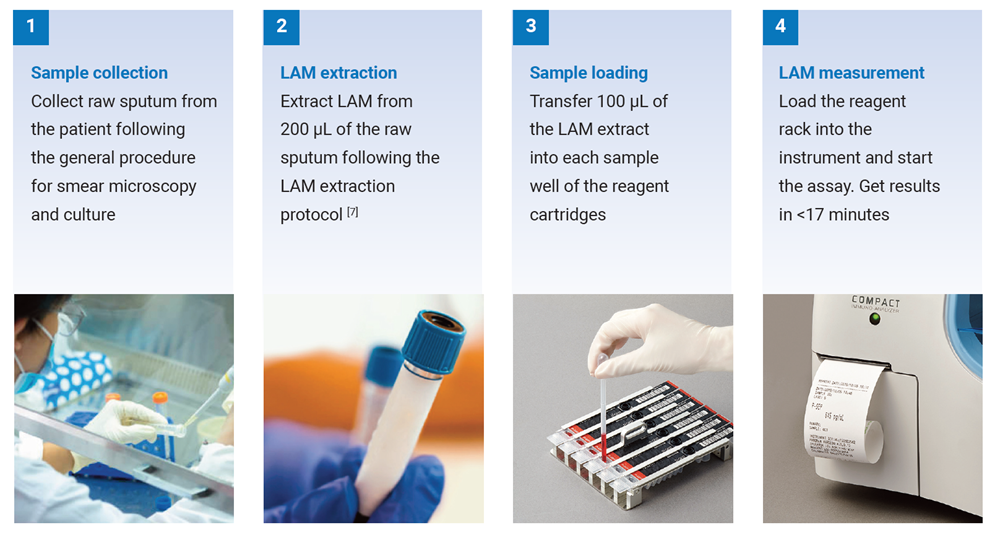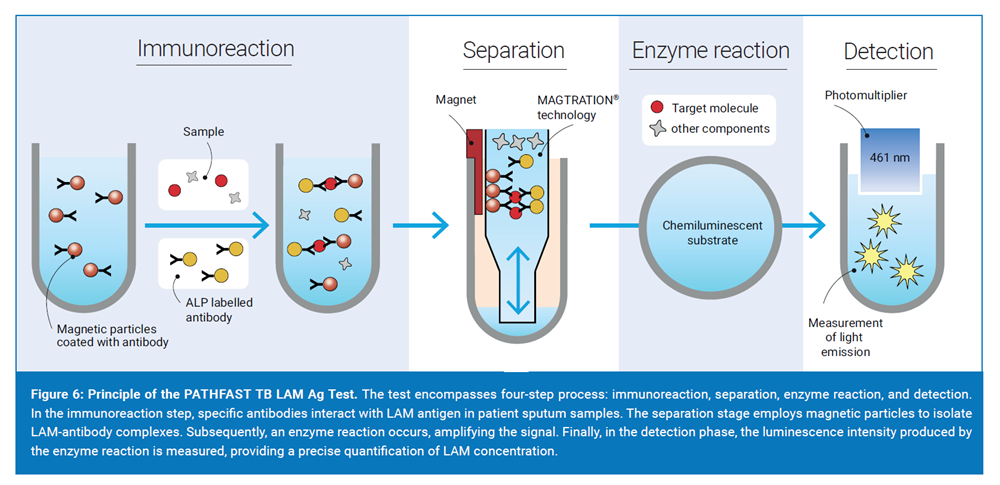PATHFAST™ TB LAM Ag Test
PATHFAST™ TB LAM Ag test is a product for in vitro diagnostic use with the PATHFAST™ automated analyser for the quantitative measurement of lipoarabinomannan (LAM) in human sputum. PATHFAST™ TB LAM Ag test is intended to be used:
- as an aid to the diagnosis of TB
- by laboratory technician, nurse or physician
- in a hospital or clinical laboratory setting.
The PATHFAST™ TB LAM Ag test procedure is based on a chemiluminescent enzyme immunoassay and MAGTRATION*. All required components for performing the testing are packed in one reagent cartridge.
By loading PATHFAST™ TB LAM Ag cartridge into the in vitro diagnostic system PATHFAST™, the quantification of LAM can be accurately measured within 17 minutes.
LAM is a 17.5 kDa glycolipid present in the mycobacterial cell wall [6] . LAM can be detected in the sputum of TB patients, and LAM concentration correlates well with the score of smear microscopy and time to detect of a culture

Benefits of choosing PATHFAST™ TB LAM Ag test
PATHFAST™ TB LAM Ag test stands out with many benefits for TB treatment monitoring due to its numerous competitive advantages.
- Minimal containment requirements: It doesn't demand high-level biosafety containment (e.g. BSL3 lab), making it ideal for resource-limited settings.
- Ease of use: Its straightforward operation that requires minimal training, streamlining workflow.
- Quantitative precision: It provides quantitative results allowing for a deeper understanding of TB treatment efficacy.
- High sensitivity: It detects lower LAM concentrations, enabling TB treatment monitoring also in patients with low bacterial loads.
- Swift results: With a turnaround time of less than an hour, it expedites clinical decision-making.
- Data-driven decisions: Its quantitative nature enables tracking of LAM concentration changes over time.
- Cost-effective: Considering its speed and accuracy, it offers a cost-effective solution for TB management.
- Could serve as a Point-of-Care test: The test shows potential for use as a point-of-care test, possibly bringing TB diagnosis and treatment monitoring closer to patients in primary care facilities and clinics.
- Reagents “all in one”: Once the sample preparation is done, no water supply & drain system and no extra washing buffer & substrate bottles needed.
The highly precise, fast and compact chemiluminescence immunoassay analysis system
PATHFAST™ TB LAM Ag test utilizes advanced technology to detect and quantify LAM which is a specific component in the cell wall of M. tuberculosis in patient sputum samples. LAM is released during active TB infection. The test uses special antibodies that create a visible signal to indicate TB treatment success. The PATHFAST™ analyzer employs a technology involving magnetic particles in a pipette tip. During the test, the sample interacts with specific antibodies and magnetic particles. After removing unwanted substances, a chemiluminescent substance (CDP-star) is added. The brightness produced during the test is used to calculate the LAM concentration in the sample.

Contact us